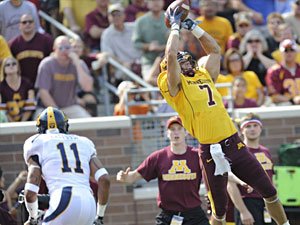Gee' whiz

Physicist Dan Dahlberg calculates the G-forces in a football collision
By Deane Morrison
Early in the second quarter of a home game against California September 19, Minnesota wide receiver Eric Decker, en route to the end zone, plucked a 26-yard pass from the air and was immediately hit by a Cal safety.
Decker scored a touchdown on the play, but the blow was so hard, it took him several minutes to get back on his feet. How hard was it? We asked University of Minnesota physics professor Dan Dahlberg to look over footage of the hit from several angles, in real time and slo-mo, and figure out how much force the safety applied to Decker during the hit.
A little background: The players collided at a right angle, with Decker running down the sideline and the safety parallel to the goal line. They hit at about the one-yard line, and both ended up out of bounds and beyond the goal line.
The Physics Force
Catch Dan Dahlberg and friends in one of two free, highly entertaining public shows by the original Physics Force. 7 p.m. Thursday, January 7, and 2 p.m. Sunday, January 10, 2010, in Northrop Auditorium, 84 Church St. S.E., Minneapolis.
Dahlberg's mission, which he chose to accept: Calculate the force of the collision in G's - the force of gravity. Since gravity, like any other force, accelerates objects, the assignment amounted to calculating the acceleration imparted to Decker's body during the collision.
If you're not the type to follow calculations, here's what Dahlberg came up with. In a contact that lasted only one-twentieth of a second, the collision applied a force of at least 10 G's, or 10 times the force of gravity, to Decker.
The accompanying video shows the action (Decker is in maroon and gold). Below the video, we'll go through the calculations.
Dahlberg started by figuring out Decker's speed heading downfield. To do that, he advanced a video frame by frame and noted how many frames it took Decker to run a certain number of yards just before the hit. Knowing the video's speed in frames per second, he was able to estimate Decker's downfield speed at 23 feet per second.
Dahlberg also examined videos from different angles and estimated that Decker hit the ground at a point 4.5 feet out of bounds and 6 feet downfield from the collision.
Next, Dahlberg estimated Decker's speed crossfield (through out-of-bounds territory). He reasoned that since the distance traveled in any direction is proportional to the speed in that direction, the ratio of the crossfield speed to the downfield speed after the hit must equal the post-hit ratio of the crossfield distance (4.5 feet) to the downfield distance (6 feet), or 0.75. Thus, the crossfield speed must be 75 percent of 23 feet per second, or 17.25 feet per second.
Let's turn now to G-forces. The acceleration due to gravity is 32 feet per second per second. That means that for every second a body is in free fall, its speed increases by 32 feet per second. Unlike gravity, though, the force of the football collision was applied for only an instant.
By counting frames in slo-mo, Dahlberg saw that contact between the two players - and thus the application of force in the crossfield direction - lasted one-twentieth, or 0.05, second. So Decker's acceleration in the crossfield direction was 17.25 feet per second divided by 0.05 second, or 345 feet per second per second. That's 10.8 times as high as gravity, or 10.8 G's.
"I read where Navy pilots taking off from aircraft carriers experience three G's, but that force is applied all over the body. The force to Decker was delivered mostly to his chest, so the pressure [force per unit area] on his chest was significantly larger than for a pilot," says Dahlberg.
With these figures in hand, it's clear that the pressures of playing college football go beyond wins and losses. And if you've ever wondered why players wear so much padding, now you know.
